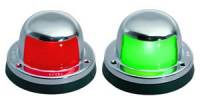 Navigation Lights – Tips for Maintaining
Navigation Lights – Tips for Maintaining
The connections inside your navigation lights live a rough life! Outside the light is always getting sprayed with seawater regularly, they eventually end up with badly corroded contacts at the light bulbs. Gold plated terminals are the answer.
Gold is one of the noblest metals we know of and it resists corrosion naturally. They are still finding gold artifacts at the bottom of the Mediterranean Sea that are in really nice shape considering their exposure to seawater for centuries!
So, when shopping for new nav light fixtures, and sooner or later you will be, make sure they have top-quality terminals. It’s just one more way to raise the bar as well as the service life and maintenance intervals for your nav lights.
Tips for Maintaining Nav Lights
- Clean the contacts of both the bulb and the fixture regularly, using fine sandpaper wrapped on a dowel. An eraser works well too.
- Coat the contacts with dielectric grease.
- Clean the wiring terminals and check them for corrosion and a tight mechanical fit.
Hit the Switch!
